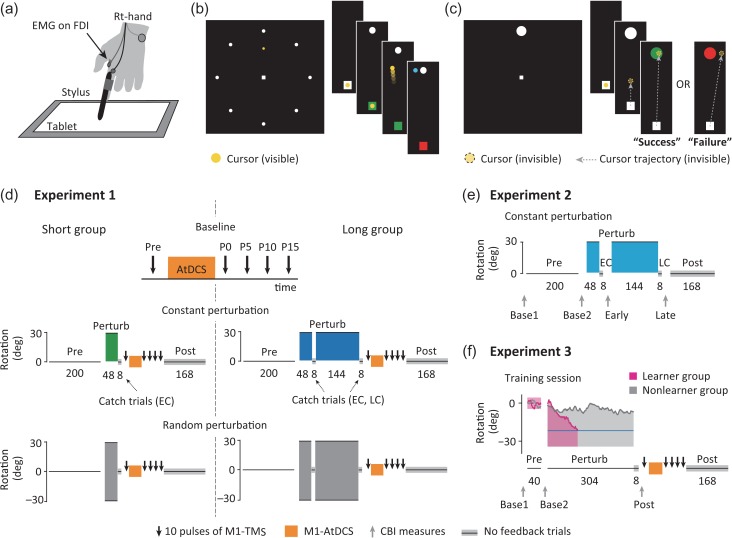Figure 1.
Experimental protocols. (a) Experimental setups. (b) Motor task for experiments 1 and 2. Subjects performed a center-out reaching controlling a yellow cursor from a central starting position to one of eight white targets while receiving online and endpoint cursor feedback (blue dot). Right panels show enlarged monitor for display purpose. (c) Motor task for experiment 3. Subjects performed a reaching from a central starting position to one target. Binary feedback (target color) about task performance was presented instead of vector cursor feedback. (d) Schematic representation of experiment 1. In a first-day “baseline” session, the AtDCS effects on M1 excitability were evaluated in the absence of motor training. Then in different days subjects participated in two counter-balanced crossover design sessions. Briefly, they trained the task in three blocks; preperturbation (Pre), perturbation (Perturb), and postperturbation blocks (Post). During the Perturb block, either a 30° (“constant perturbation” session) or trial-by-trial pseudo-randomized rotations (“random perturbation” session) were applied to cursor movement. The AtDCS effects were evaluated after the Perturb block. The numbers under each block represent the amount of trials. Note that the main difference between short and long groups was that the long group performed one additional Perturb block. (e) Schematic representation of experiment 2. Subjects participated in two-day counter-balanced crossover design sessions where training the same task as the long group in experiment 1 (the random perturbation session is not shown). CBI was obtained before (Base1) and after (Base2) the Pre block, and after the first (Early) and the second Perturb blocks (Late). (f) Schematic representation of experiment 3. After a baseline session where the AtDCS effects were evaluated (not shown in the panel), subjects trained the task through three blocks in a second-day “training” session. During the Perturb block, a range for task success (shaded area in magenta and gray) was shifted from the original range used in the pre block toward clockwise direction according to a moving average of the previous 10 reach angles (examples are shown in magenta and gray lines). The Perturb block terminated when the moving average reached a predetermined certain degree (blue horizontal line), otherwise it terminated when the number of trials reached 304. The AtDCS effects were evaluated after the Perturb block, and CBI measures were performed before (Base1) and after the Pre block (Base2), and after the Perturb block (Post).

